Univ in the Arts: Women and Word
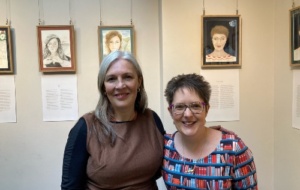
Daisy Harcourt (1990, Fine Art) and Dr Laura Varnam
All members of Univ were invited to attend a private view and conversation with Daisy Harcourt (1990, Fine Art) and Dr Laura Varnam, Lecturer in Old and Middle English Literature, on Thursday 18 April 2024 at the Town House, Spitalfields, London. The event was organised by members of the Univ in the Arts Committee: Ali Mercer, Philippa Malicka, Jonathan Hourigan, Chris Birkett, Caroline Marriage, Mary Orsak and Ruqayah Juyel alongside Martha Cass in the Development Office.
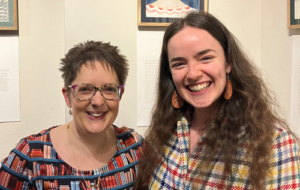
Dr Laura Varnam and Matilda Warner
Matilda Warner (2016, English) has kindly written the following account:
“I like good strong words that mean something.” So says Louisa May Alcott’s Jo March, one of my literary heroines. Words are immensely powerful alone or together, but the meaning of each can become richer or weaker over time, imbued with the wear and tear of the great recycling bin of Language. Words are constantly evolving, stretching, shrinking, and emerging out of unlikely places. So which ones would we use to describe ourselves, and which would we say mean the most to us? Particularly we women, for whom access to the room of published words was, for a long time, firmly barred. Imagine, therefore, choosing words – good strong ones, mind – that feel somehow part of you, describing who you are, and then imagine someone depicting you through these words in a beautiful portrait. Speculate no further, for it has been done with delicate aplomb by artist and Univ alumna Daisy Harcourt.
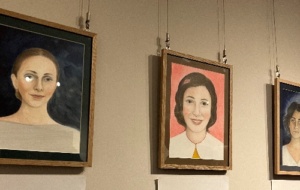 Last month, I was thrilled to have the opportunity to view a collection of Daisy’s exquisitely expressive portraits, which I had long been admiring online, at the latest Univ in the Arts event in London: “Women & Word”. Daisy’s portraits of 14 contemporary women and several inspirational women writers, were, until recently, populating the gallery at Town House Spitalfields. The exhibition space is a bright room tucked behind an 18th-century townhouse. Sheltered from the fringes of the City and its shuffling briefcases, it has a warm aura of welcoming interestingness. It was the perfect spot in which to house these twenty or so faces, hung in simple wooden frames. I doubt any visitors were deceived by the deceptively soft effect. It is a powerful feeling, being surrounded by women, and only women, staring out at you. Following a drinks reception with the portraits quietly joining in, we settled upstairs for the evening’s discussion. The atmosphere was comfortable yet galvanic; all happily squeezed into the snug salon, there was an immediate sense of togetherness, with plenty of questions and discussions after the main conversation.
Last month, I was thrilled to have the opportunity to view a collection of Daisy’s exquisitely expressive portraits, which I had long been admiring online, at the latest Univ in the Arts event in London: “Women & Word”. Daisy’s portraits of 14 contemporary women and several inspirational women writers, were, until recently, populating the gallery at Town House Spitalfields. The exhibition space is a bright room tucked behind an 18th-century townhouse. Sheltered from the fringes of the City and its shuffling briefcases, it has a warm aura of welcoming interestingness. It was the perfect spot in which to house these twenty or so faces, hung in simple wooden frames. I doubt any visitors were deceived by the deceptively soft effect. It is a powerful feeling, being surrounded by women, and only women, staring out at you. Following a drinks reception with the portraits quietly joining in, we settled upstairs for the evening’s discussion. The atmosphere was comfortable yet galvanic; all happily squeezed into the snug salon, there was an immediate sense of togetherness, with plenty of questions and discussions after the main conversation.
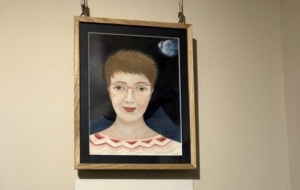 Dr Laura Varnam, who chaired the event, is one of the 14 exhibition subjects, and also the author of the catalogue introduction. As a Lecturer in Old and Middle English Literature and a Univ English tutor, Laura is fully aware of how relatively recently “Women and Word” were mutually exclusive in Oxford, let alone in the wider world. “I write this introduction from a room of my own in Oxford”, her preface begins. As one of Laura’s former undergraduate students, I am pleased to say I know said room very well, and I miss sitting among the many books, prints, and objects which encapsulate who Laura is as a thinker, tutor, and writer.
Dr Laura Varnam, who chaired the event, is one of the 14 exhibition subjects, and also the author of the catalogue introduction. As a Lecturer in Old and Middle English Literature and a Univ English tutor, Laura is fully aware of how relatively recently “Women and Word” were mutually exclusive in Oxford, let alone in the wider world. “I write this introduction from a room of my own in Oxford”, her preface begins. As one of Laura’s former undergraduate students, I am pleased to say I know said room very well, and I miss sitting among the many books, prints, and objects which encapsulate who Laura is as a thinker, tutor, and writer.
Facing a pictorial representation of oneself is not something with which everyone is comfortable, but Daisy’s ability to translate self-descriptions and favourite words into portraits brimming with personality – whether conveyed by a vivid background, their facial expression, words spelled around their heads, a breeze through their hair, or even a particular glint in their eyes – is a work of artistic magic. It is a true collaboration of the artist and the sitter, and it was a joy to listen to Daisy and Laura, who have clearly bonded over the time spent creating Laura’s portrait – notwithstanding jesting debates over hair – as they discussed the sitter’s trust in Daisy to render chosen words into her own impression of who a person is. Laura’s introduction describes this transformation as translation, in its true etymological sense of ‘carrying across’. Each of Daisy’s portraits carries a truly personal piece of its subject.
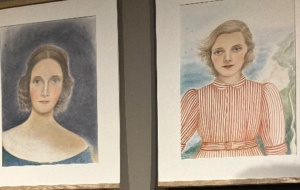 “This exhibition is a room of our own and we are delighted to welcome you,” writes Laura. In Daisy’s portraits, almost every woman looks directly at us – something remarkable in its rarity in our most prestigious art galleries – as if to defy and befriend the viewer simultaneously. Only one, Jo, looks away, considering a smooth stone in her hands, and the way in which this links to her very visceral description of the material, physical effect of words, as if powerful enough to leap into and alter landscapes, is rather special. Jo is an artist, her medium is stone. The tying together of Jo’s linguistic imagery and the depicted Jo also links to her own ideas of coincidence and overlap when we read: as she notes, when we consider something, it will have been considered before, and will be so again. The noting down of these thoughts which we share in common is the rather wonderful thing about the written word, each thought a stitch in a very long tapestry across time. It is the way in which we express them that marks our individuality. Indeed, the tender connection between artist and sitter is a hymn to individuality – Daisy recalled that at the sitting stage, she fell for each person who trusted her with that intimate experience. It produces an effect on those looking at her work, too; you feel part of something, and as a woman brought up in world in which fewer women are artistically represented than men, this is an empowering feeling. I couldn’t help thinking of the Guerrilla Girls’ ground-breaking works “The Advantages of Being a Woman Artist” and “Do women have to be naked to get into the Met. Museum?” More recently, Katy Hessel’s bestselling book The Story of Art Without Men addressed the absence of women in the artistic canon, opening with Artemisia Gentileschi – who naturally entered the evening’s discussion – and her own defiant words of 1649: “I’ll show you what a woman can do.”
“This exhibition is a room of our own and we are delighted to welcome you,” writes Laura. In Daisy’s portraits, almost every woman looks directly at us – something remarkable in its rarity in our most prestigious art galleries – as if to defy and befriend the viewer simultaneously. Only one, Jo, looks away, considering a smooth stone in her hands, and the way in which this links to her very visceral description of the material, physical effect of words, as if powerful enough to leap into and alter landscapes, is rather special. Jo is an artist, her medium is stone. The tying together of Jo’s linguistic imagery and the depicted Jo also links to her own ideas of coincidence and overlap when we read: as she notes, when we consider something, it will have been considered before, and will be so again. The noting down of these thoughts which we share in common is the rather wonderful thing about the written word, each thought a stitch in a very long tapestry across time. It is the way in which we express them that marks our individuality. Indeed, the tender connection between artist and sitter is a hymn to individuality – Daisy recalled that at the sitting stage, she fell for each person who trusted her with that intimate experience. It produces an effect on those looking at her work, too; you feel part of something, and as a woman brought up in world in which fewer women are artistically represented than men, this is an empowering feeling. I couldn’t help thinking of the Guerrilla Girls’ ground-breaking works “The Advantages of Being a Woman Artist” and “Do women have to be naked to get into the Met. Museum?” More recently, Katy Hessel’s bestselling book The Story of Art Without Men addressed the absence of women in the artistic canon, opening with Artemisia Gentileschi – who naturally entered the evening’s discussion – and her own defiant words of 1649: “I’ll show you what a woman can do.”
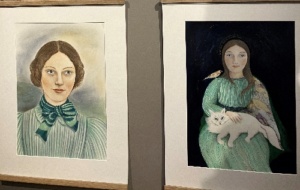 Within their discussion, Laura and Daisy touched on Univ’s own hall, in which only one painting of a woman hangs: the legendary Professor Helen Cooper. I was lucky to meet Helen during my year as Univ JCR Women’s Representative, when we invited her to join a formal dinner to begin the celebrations for forty years of women at the College in 2018-2019. Her first influx of students in 1979 included founding member of the Univ in the Arts committee, novelist Amanda Brookfield, who was the first Visitor in the Arts at College that anniversary year. Connections across the years between women through words, whether in the role of tutor, student, friend, mother, sister, or as the name on the front of a book in one’s hands, are each indelible, lifelong bonds. Fittingly, the Town House gallery is just around the corner from the birthplace of writer, philosopher and women’s rights advocate Mary Wollstonecraft.
Within their discussion, Laura and Daisy touched on Univ’s own hall, in which only one painting of a woman hangs: the legendary Professor Helen Cooper. I was lucky to meet Helen during my year as Univ JCR Women’s Representative, when we invited her to join a formal dinner to begin the celebrations for forty years of women at the College in 2018-2019. Her first influx of students in 1979 included founding member of the Univ in the Arts committee, novelist Amanda Brookfield, who was the first Visitor in the Arts at College that anniversary year. Connections across the years between women through words, whether in the role of tutor, student, friend, mother, sister, or as the name on the front of a book in one’s hands, are each indelible, lifelong bonds. Fittingly, the Town House gallery is just around the corner from the birthplace of writer, philosopher and women’s rights advocate Mary Wollstonecraft.
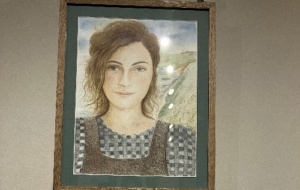 It was Laura who inspired Daisy to depict Daphne du Maurier among the collection, and the way in which she, Charlotte Brontë, Pippi Longstocking, Mary Wollstonecraft herself and her daughter Mary Shelley, along with several other literary inspirations, met the eyes of their contemporary counterparts was a visual reminder of this ongoing, intergenerational conversation. I wouldn’t be surprised if, when the Town House turned off its lights and locked the doors each night, Daisy’s subjects began to chatter away to each other. If a picture paints a thousand words, then think how many words were in that room of storytellers: as Laura described, a veritable Old English wordhoard. We are each of us made up of so many words, and her introduction summarises their vital power: “They can be anchors in a storm. Words are maps; a way out, or a way back to ourselves; paths to new worlds and new experiences. Words, for those of us who are drawn to write, are where we live.” The path of stringing together words can be a painful one, sometimes, beset with obstructions both creative and practical. For women over time, many of these took the form of monetary, societal, familial obstructions, and it is this which makes up Virginia Woolf’s argument in A Room of One’s Own. We are fortunate now to live in a fairer society than Woolf’s time, but it is still difficult as a woman to juggle an artistic calling with a job, a relationship, a family. It is difficult for anyone, regardless of gender, to pursue an artistic calling; it is often a battle with allotted time. As Laura took us through Daisy’s life and her work, I was struck by Daisy’s honesty in recounting how life’s surprises have interrupted, but often deepened, her art. The desire to create was always there, from her Fine Arts degree at Univ to the work she vowed to make on the basis of her son’s recovery from a life-threatening medical condition in the darkest era of the pandemic. But through all of life’s slings and arrows, Daisy’s work has emerged, and each of us who attended the event that evening felt glad that she persisted, that it is these portraits that have bloomed out of words between, about, and belonging to, such a wonderful group of women.
It was Laura who inspired Daisy to depict Daphne du Maurier among the collection, and the way in which she, Charlotte Brontë, Pippi Longstocking, Mary Wollstonecraft herself and her daughter Mary Shelley, along with several other literary inspirations, met the eyes of their contemporary counterparts was a visual reminder of this ongoing, intergenerational conversation. I wouldn’t be surprised if, when the Town House turned off its lights and locked the doors each night, Daisy’s subjects began to chatter away to each other. If a picture paints a thousand words, then think how many words were in that room of storytellers: as Laura described, a veritable Old English wordhoard. We are each of us made up of so many words, and her introduction summarises their vital power: “They can be anchors in a storm. Words are maps; a way out, or a way back to ourselves; paths to new worlds and new experiences. Words, for those of us who are drawn to write, are where we live.” The path of stringing together words can be a painful one, sometimes, beset with obstructions both creative and practical. For women over time, many of these took the form of monetary, societal, familial obstructions, and it is this which makes up Virginia Woolf’s argument in A Room of One’s Own. We are fortunate now to live in a fairer society than Woolf’s time, but it is still difficult as a woman to juggle an artistic calling with a job, a relationship, a family. It is difficult for anyone, regardless of gender, to pursue an artistic calling; it is often a battle with allotted time. As Laura took us through Daisy’s life and her work, I was struck by Daisy’s honesty in recounting how life’s surprises have interrupted, but often deepened, her art. The desire to create was always there, from her Fine Arts degree at Univ to the work she vowed to make on the basis of her son’s recovery from a life-threatening medical condition in the darkest era of the pandemic. But through all of life’s slings and arrows, Daisy’s work has emerged, and each of us who attended the event that evening felt glad that she persisted, that it is these portraits that have bloomed out of words between, about, and belonging to, such a wonderful group of women.
I for one am looking forward to following Daisy’s future projects, and express my thanks to the Univ in the Arts committee for organising such a stimulating evening. As I walked away, I felt a renewed hope that, with the conversation and writings of artists past and present whispering all around us, creative endeavours are bound to bloom if we put our minds to them. In the unerringly meaningful words of Jo March, “I’ve got the key to my castle in the air, but whether I can unlock the door remains to be seen.”
Published: 3 June 2024
